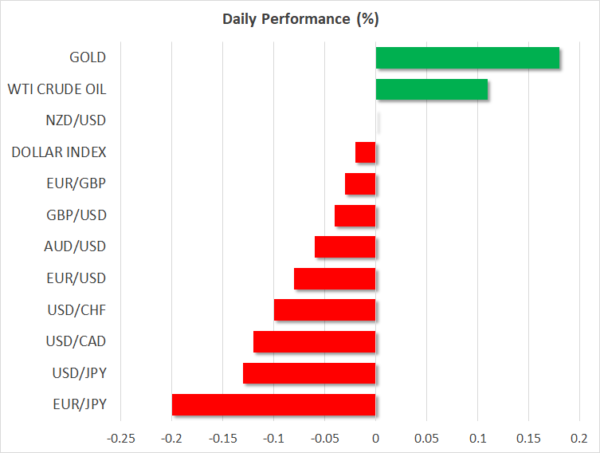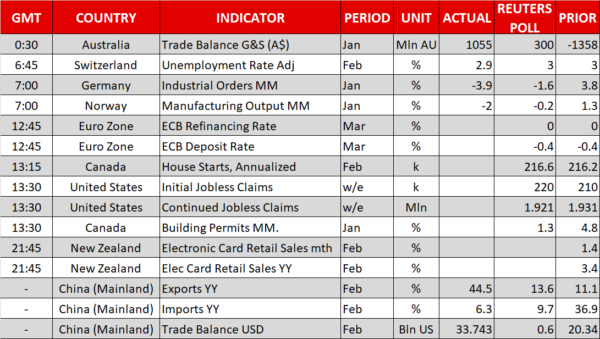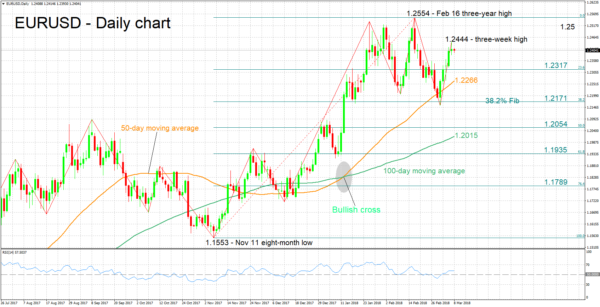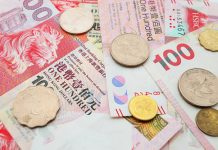Here are the latest developments in global markets:
FOREX: The dollar was roughly flat versus a basket of currencies after recovering somewhat from a two-week low hit on Wednesday. The recovery came on the back of abating worries over a trade war occurring, as well as optimism on the strength of the US labor market.
STOCKS: US markets traded in a turbulent manner yesterday. They opened lower on trade concerns following Gary Cohn’s resignation, but managed to recover most of their losses before the close, after news that Canada and Mexico may be exempt from tariffs calmed the nerves of investors. The Nasdaq Composite rose by 0.3%, the S&P 500 closed marginally lower, while the Dow Jones fell by 0.3%. Futures tracking the Dow, S&P, and Nasdaq 100 are currently very close to being flat. Asian markets were a sea of green today, as trade concerns eased somewhat. In Japan, the Nikkei 225 and the Topix climbed 0.5% and 0.4% respectively, while in Hong Kong, the Hang Seng trade higher by 1.5%. In Europe, futures tracking all the major benchmarks were flashing green.
COMMODITIES: Oil prices traded marginally higher today, with WTI and Brent crude both gaining 0.1%. However, this follows a sharp tumble yesterday, which was triggered after the EIA data showed another increase in US crude inventories, and US crude production hitting a record high. In precious metals, gold traded 0.2% higher today, last seen near the $1327/ounce handle. Price action in the yellow metal continues to be driven by uncertainties surrounding trade and as such, it declined overall yesterday, as trade concerns subsided a little.
Major movers: Dollar recovers though remains close to 2-week low with trade developments still dominating attention
The possibility of Canada and Mexico, as well as some other countries, being exempted from planned US tariffs led to the easing of concerns over trade, allowing the dollar index to rise from the two-week low of 89.41 hit yesterday. At 0731 GMT, the index was at 89.62.
A White House official said overnight that the Trump administration could offer Canada and Mexico a 30-day exemption from planned tariffs on steel and aluminum imports, with the period potentially being extended based on progress in NAFTA talks.
Despite some calmness setting in among market participants, uncertainty over trade remains in place and could lead to further volatility moving forward.
February’s ADP report on positions added to the economy by the US private sector, which is viewed by some analysts as a precursor to the nonfarm payrolls (NFP) report, also spurred optimism on the strength of the jobs market and supported the greenback. The NFP reading is due on Friday.
Euro/dollar traded 0.1% lower at 1.24 ahead of the conclusion of the ECB meeting on monetary policy later on Thursday. Dollar/yen was 0.15% lower at 105.90, with the BoJ concluding its respective meeting on monetary policy on Friday. Pound/dollar was not much changed around the 1.39 handle.
The Canadian dollar revisited an eight-month low on Wednesday, with dollar/lonnie touching 1.30 as the BoC made mention to trade fears as it kept rates unchanged upon completion of its two-day meeting. The loonie recovered a bit, helped by news that Canada may be exempted from US tariffs. Dollar/lonnie was 0.1% lower at 1.2894. The Mexican peso also benefitted from the tariff-exemption news.
The aussie was little changed versus the US currency and the kiwi was flat, as market participants awaited details of US tariff plans. Australia and New Zealand rely on commodity exports and potentially stand to lose in case a trade war breaks out.
Day ahead: ECB decision to set the tone for the euro; Trump expected to formally sign off on tariffs
Today, the spotlight will be on the European Central Bank policy decision at 1245 GMT, which will be followed by a press conference from President Draghi at 1330 GMT. The Bank is widely anticipated to remain on hold and as such, investors will be on the lookout for updated signals on the future evolution of policy. Specifically, attention will be on whether policymakers will tweak their forward guidance in a hawkish direction, by removing the sentence that they stand ready to increase the QE program in size and/or duration if the economic outlook becomes less favorable.
Importantly, the ECB has been discussing a potential adjustment in its language since its December meeting. A removal of that sentence today would pave the way for an eventual end to the QE program later this year, and could unleash another round of gains in the common currency. Conversely, if the Governing Council decides to be patient and keep its guidance unchanged, that may spell bad news for the euro as investors begin to doubt whether the Bank will indeed exit its QE program this year. Besides the forward guidance, euro-traders will focus on the updated economic forecasts, as well as Draghi’s remarks, especially any comments on the exchange rate.
In the US, all eyes will be on the White House, where President Trump is anticipated to formally sign off on the steel and aluminum tariffs his administration announced last week. The timing of this event is still tentative though, and it may well be delayed until tomorrow according to officials. The US administration announced yesterday that Canada and Mexico may be exempted from the proposed tariffs, and other countries could possibly join that list as well. Thus, investors will be looking to see which other economies are exempted, as they gauge the probability of this situation escalating into a retaliatory trade war. Based on the latest market reactions though, particularly the surge in stock markets, the financial community seems to be taking the view that these tariffs will be watered down and could end up being more symbolic in nature. At this stage, however, this may be a premature conclusion to draw.
As for economic data, the calendar is almost empty today, with the only noteworthy releases being Canadian housing starts for February and US initial jobless claims for the week ended February 2, due out at 1315 GMT and 1330 GMT respectively.
Equity markets are likely to continue focusing on tariffs and how the global trading environment will evolve.
Besides ECB President Draghi, we will hear from the Bank of Canada’s Deputy Governor Timothy Lane at 2030 GMT. Investors may look to his comments for some clarity following yesterday’s policy decision, as there was no press conference after that gathering for the Bank to communicate its thinking more clearly.
Technical Analysis: EURUSD looking neutral in the short-term ahead of ECB
EURUSD has declined a bit after hitting a three-week high of 1.2444 during Wednesday’s trading. The RSI has halted its advance and is moving sideways, pointing to a neutral short-term picture.
A hawkish message by the ECB later today is anticipated to be met with long EURUSD positions. In this scenario, some resistance could come around yesterday’s high of 1.2444 before the focus shiftis to the 1.25 handle that may hold psychological significance and could act as a barrier to the upside.
A dovish tone by the ECB on the other hand, is likely to lead to weakness in the pair. In this case, support could come around the 23.6% Fibonacci retracement level of the November 11 to February 16 upleg, at 1.2317.
















